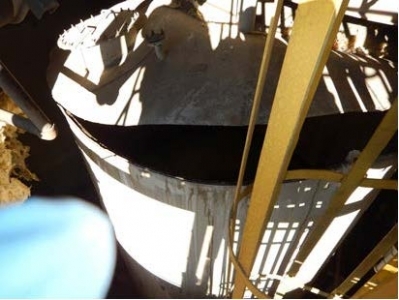Surface – Copper Ore Molybdenum Recovery Circuit – On November 3, 2016, an explosion occurred when a miner unloaded a truckload of sodium hydrosulfide (NaHS) solution using compressed air into a chemical storage tank that contained calcium polysulfide (CaPS) solution. Both NaHS and CaPS give off hydrogen sulfide (H2S), a flammable and toxic gas that produces a “rotten-egg” odor. The operator had installed a charcoal filter on the tank’s vent line to control the odors. Each chemical had been off-loaded individually without incident, but when these chemicals came into contact in the tank, an explosive concentration of H2S gas was liberated that exceeded the filter’s design capacity. A rapid generation of heat resulted and the charcoal filter ignited. The filter was not equipped with a flame arrestor. After the compressed air was turned off, H2S vapors in the tank ignited causing a violent explosion damaging the tank, surrounding area, and building. This accident occurred because the operator changed its process using a system which was not properly designed.
- Equip chemical storage tanks with properly-designed pressure relief devices that are safely vented.
- Charcoal filter and scrubber systems should be properly designed and rated for the intended application. Systems should be maintained and inspected regularly.
- Prior to implementing a process change, such as a new mixture of chemicals, thoroughly evaluate potential hazards.
- Establish procedures for the safe handling and storage of chemicals, ensuring chemical compatibility with the process and equipment.
- Conduct continuous H2S monitoring in areas where it may accumulate.
- Do not use pressurized air to off-load NaHS solution without appropriate controls.
- Train miners on chemical hazards and emergency response procedures.
- Use proper personal protective equipment during chemical handling.
- For additional safe practices and precautions when handling NaHS, refer to the U.S. Chemical Safety and Hazard Investigation Board’s Safety Bulletin No. 2003-03-B (November 2004)

